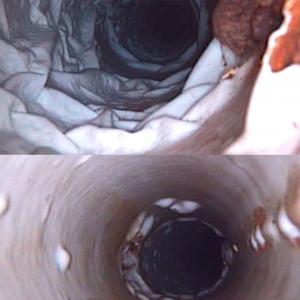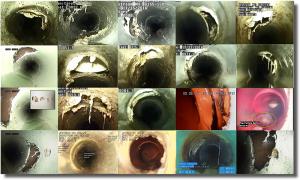American & British Water Utilities Adopt Trenchless Cured-In-Place Pipe (CIPP)
Published on by Water Network Research, Official research team of The Water Network in Business
Outdated Visual Inspection of Widely Used CIPP Being Replaced By Machine-Based Technology to Locate & Quantify Leaks Missed by CCTV Cameras
It's the dirty little secret of the industry that poorly cured or badly installed CIPP liners can leak. And, pipes can actually leak more after CIPP, if customer services are not properly restored.”
— Chuck Hansen, Chairman & Founder, Electro Scan Inc.
SACRAMENTO, CALIF., USA, July 2, 2020 /EINPresswire.com/ -- Yesterday, in the early morning hours in Great Britain, Brad Weston, Director, Electro Scan (UK) Limited, used a machine-intelligent technology to test recently installed underground pipes that promised a 50-year useful life by lining old pipes, without the need to dig up streets or even a farmer's field.
A few hours later in the United States, Mackenzie App, Field Services Manager, Electro Scan Inc., began scanning Cured-In-Place Pipe (CIPP), representing a trenchless method of pipe rehabilitation, demonstrating the growing demand for quality assurance testing of a widely used repair technique.
CIPP has enjoyed a long history in the municipal and utility construction industry without much quality assurance testing once the new pipe is installed underground.
In 1971, Eric Wood first implemented cured-in-place pipe technology in London, England, calling the process 'insitu form' derived from the Latin meaning "form in place". Granted a patent in 1977 the process entered the public domain in 1994, with the majority of lining contractors and suppliers only required to submit CCTV inspections without the requirement to test full-length 360-degree liners for watertightness.
Both UK and US Electro Scan CIPP surveys were performed in accordance with strict COVID-19 health & safety requirements finding and measuring leaks in Liters per Second and Gallons per Minute, respectively, with worldwide testing performed throughout the pandemic.
Missed by high resolution Closed-Circuit Television (CCTV) cameras, Electro Scan's patented and patent-pending technology provides truth-testing of lined pipes, including all pipe materials for gravity sewer mains, pressurized water mains, and force mains, called sewer rising mains outside of the United States.
While U.S. sewer and water utilities are adding Electro Scan's Focused Electrode Leak Location (FELL) into CIPP specifications as an acceptance requirement, UK water utilities just starting AMP7 are realizing the need to conduct quality assurance testing to provide environmentally resilient and sustainable piping networks.
Despite over a dozen start-ups looking to apply artificial intelligence and machine learning to help municipal utilities and consulting engineers to properly review hours of CCTV videos, the inability for CCTV cameras to tell superficial cracks from cracks that go through a pipe wall, evaluate inside the bell & spigot of joints, or evaluate the permeability of CIPP liners, created the need for a machine-intelligent solution that could give cost-effective unambiguous, unbiased, and uncontested test results.
"It's the dirty little secret of the industry that poorly cured or badly installed CIPP liners can leak," states Chuck Hansen, Chairman and Founder, Electro Scan Inc. "And, pipes can actually leak more after CIPP, if customer services are not properly restored."
In 2019, Electro Scan inspected over 110,000 LF of CIPP liners using its low voltage conductivity technology, locating over 14,000 leaks in trenchless liners, or approximately one leak every 8 feet.
More alarming, for the twelve months ending December 31, 2019, over 80% of CIPP liners inspected had measurable defects contributing to unwanted inflow and infiltration (I/I).
These results are up from 78% in the company's 2018 survey, with 44% of liners having leaks of more than 20 Gallons per Minute.
Electro Scan’s Focused Electrode Leak Location (FELL) technology has tested CIPP lining materials from over thirty (30) suppliers, worldwide.
Based on a recent online poll conducted as part of its Electro Scan’s Trenchless Technology Webinar held in March 2020, 35% of municipal agencies have had disputes with CIPP Contractors or issues with their liner after warranty expiration.
In addition to assessing newly lined sewer mains, directly after CIPP installation, Electro Scan's new multi-sensor probe for pressurized water mains and force mains is able to assess pressurized CIPP liners while in service and without customer interruption.
Problems with CIPP and the limitations for CCTV to accurately test liners have been well-documented.
In 2012, the USEPA published its 'Study Report Evaluation of CIPP In Municipal Gravity Sewers' (EPA 600 R-12 004_R), stating that municipal utilities could only identify deterioration or defects that were easily identified visually and that liner distortions were difficult to identify.
The USEPA also found significant differences testing CIPP liner coupons. In one city a CIPP liner reported a finished thickness of 7.5mm, while the EPA-funded study showed an average measured liner thickness of 5.72mm.
Last year, a paper presented at the 2019 North American Trenchless Technology conference, titled 'Addressing the Shortcomings of a Sampling Strategy in CIPP Quality Assurance Programs' stated "while CIPP technologies have improved, the ability of contractors to obtain more consistent quality installations has not yet been demonstrated."
Hours apart, Electro Scan field crew members Mackenzie App in the United States and Brad Weston in the United Kingdom test Cured-In-Place Pipe (CIPP) showing the growing demand for machine-intelligent technology to test the watertightness of new and existing pipes.
Defective CIPP liners in pressurized water mains.
Low voltage conductivity allows utilities to automatically identify location and severity of defects in Cured-In-Place Pipe (CIPP) and other trenchless rehabilitation.
Example defective customer reconnections, after CIPP installation and lateral reinstatement.
Widespread Use of Cured-In-Place Pipe (CIPP) for Trenchless Rehabilitation Results in Increase Demand for Early Warning QA/QC of Leaks, Pinholes, and Liner Permeability.
Taxonomy
- Utility Pipe Network
- Pipeline Rehabilitation
- Pipe Relining
- Pipes and Pipelines

